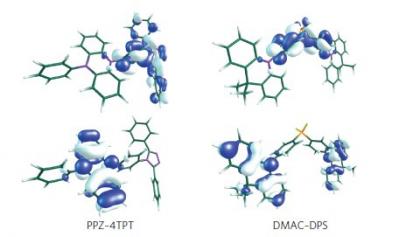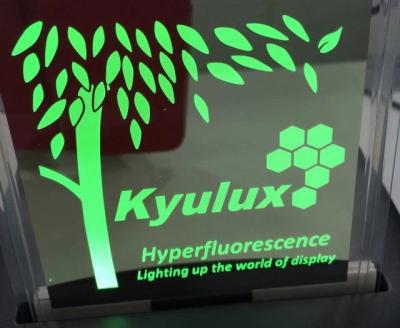 Kyulux, established in Japan in 2015, develops next generation materials for OLED displays and lighting.
Kyulux, established in Japan in 2015, develops next generation materials for OLED displays and lighting.
Based on exclusively-licensed technology from Kyushu University, Kyulux develops 4th-generation Hyperfluorescence TADF emitters that enable cost-effective, durable and efficient OLEDs that do not rely on rare metals. Kyulux is developing red, green, yellow and blue HF emitter systems.
In 2016 Kyulux raised $13.5 million from Samsung, LG, Japan Display, JOLED and more, and in 2019 the company announced it raised $31.8 million in its Series B round.
In October 2019 Wisechip launched the world's first Hyperfluorescence TADF OLED display, a 2.7" yellow PMOLED that adopts Kyulux's HF emitter system. Kyulux started shipping commercial TADF materials for Wisechip in April 2020.
4-1 Kyudai-Shinmachi, Nishi-ku
Fukuoka Industry-Academia Symphonicity (FiaS) Bldg.2
Fukuoka,
819-0388
Japan
Recent advances in TADF emitters reported towards DisplayWeek 2017
TADF are getting a lot of attention now, as a promising new emitter type that could finally enable efficient blue emission, and also efficient alternative to red and green phosphorescent emitters.

Several new TADF research papers have been announced by SID and will be presented at DisplayWeek 2017. Below you will find a list of these recent achievements, at no particular order.
Is TADF the future of efficient OLED emitters?
TADF, or Thermally Activated Delayed Fluorescence, represents a class of OLED emitter materials that aim to provide efficient and long-lifetime performance. TADF research started in earnest in 2012, and some believe that TADF represent an exciting new platform for next-gen OLED emitters.

As OLED display adoption grows, researchers and developers at Universities and companies are looking to develop more efficient and cost-effective OLED materials. There are currently three main drivers for these efforts - the development of an efficient and long-lasting blue color emitter, the development of alternative non-phosphorescent emitters and the development of soluble materials that can be deposited in ink-jet printing and other "wet" methods.
Kyulux licenses Harvard's material screening software
Last week we reported about a new large-scale computer-driven material screening process that was developed by Researchers from Harvard University, MIT and Samsung.
The so-called Molecular Space Shuttle system combines theoretical and experimental chemistry, machine learning and cheminformatics, with an aim to quickly identify new OLED molecules (the system was already used to deisgn more than a 1,000 new high-performance blue-light emitting molecules). Today Kyulux announced that it secured a license to Harvard University’s Molecular Space Shuttle deep learning system.
Kyulux: advancing fast to commercialize yellow, green and blue TADF emitters
 In early 2016, Kyushu University in Japan spun-off a new start-up called Kyulux to commercialize the TADF emitters developed at the University. A few months later, Kyulux raised $13.5 million (from LG, Samsung, Japan Display and JOLED).
In early 2016, Kyushu University in Japan spun-off a new start-up called Kyulux to commercialize the TADF emitters developed at the University. A few months later, Kyulux raised $13.5 million (from LG, Samsung, Japan Display and JOLED).
We have met with Kyulux's team at SID 2016, who updated us that the company is progressing fast on the way to commercialize those TADF emitters. The first products to be ready are green and yellow emitters. Kyulux says that its Hyper-fluorescence TADF emitters offer a superior performance compared to PHOLED emitters (in both intensity and color purity) - and they should also be priced lower - so the company aims to provide a viable alternative to UDC's emitters in the near future.
Kyulux announces its full investor list - which includes SDC, LGD, JDI and JOLED
 Last week we reported that Kyushu University spun-off a new company, called Kyulux, to commercialize the TADF emitters developed at Kyushu. Kyulux raised $13.5 million USD, and today the company made an official announcement - including the full investor list.
Last week we reported that Kyushu University spun-off a new company, called Kyulux, to commercialize the TADF emitters developed at Kyushu. Kyulux raised $13.5 million USD, and today the company made an official announcement - including the full investor list.
It turns out that besides LG Display, Kyulux lists Samsung Display, Japan Display and JOLED as investors. The round was led by Samsung Venture Investment Corporation and other participants include top tier Japanese venture capital funds, and a Japanese Government affiliated venture fund.
LG Display invests $2.8 million in TADF developer Kyulux
Earlier this month we reported that Kyushu University spun-off a new company, called Kyulux, to commercialize the TADF emitters developed at Kyushu. Kyulux raised ¥1.5 billion (around $13 million USD) and hopes to have their emitters ready by 2018.

According to the OLED Association, LG Display now invested a further $2.8 million in Kyulux. Kyulux also signed an agreement with Kyushu University to transfer 50 patents. Kyulux did not specify how much they paid for those patents - but it did say that the series A round (those $13 million) were raised at least partly to buy those patents.
New startup to commercialize Kyushu's TADF emitters
Researchers from Kyushu University (led by Chihaya Adachi) are developing highly efficient blue OLED TADF (Thermally Activated Delayed Fluorescence, also called hyper-fluorescence) emitters.

Kyushu University now spun-off a new company, called Kyulux, backed by the University's QB Fund and the Japan Society for the Promotion of Science, to commercialize the TADF emitters. Kyulux raised ¥1.5 billion (around $13 million USD) and hopes to have their emitters ready by 2018.
Kyulux
 Kyulux, established in Japan in 2015, develops next generation materials for OLED displays and lighting.
Kyulux, established in Japan in 2015, develops next generation materials for OLED displays and lighting.
Based on exclusively-licensed technology from Kyushu University, Kyulux develops 4th-generation Hyperfluorescence TADF emitters that enable cost-effective, durable and efficient OLEDs that do not rely on rare metals. Kyulux is developing red, green, yellow and blue HF emitter systems.
In 2016 Kyulux raised $13.5 million from Samsung, LG, Japan Display, JOLED and more, and in 2019 the company announced it raised $31.8 million in its Series B round.
Pagination
- Previous page
- Page 4



